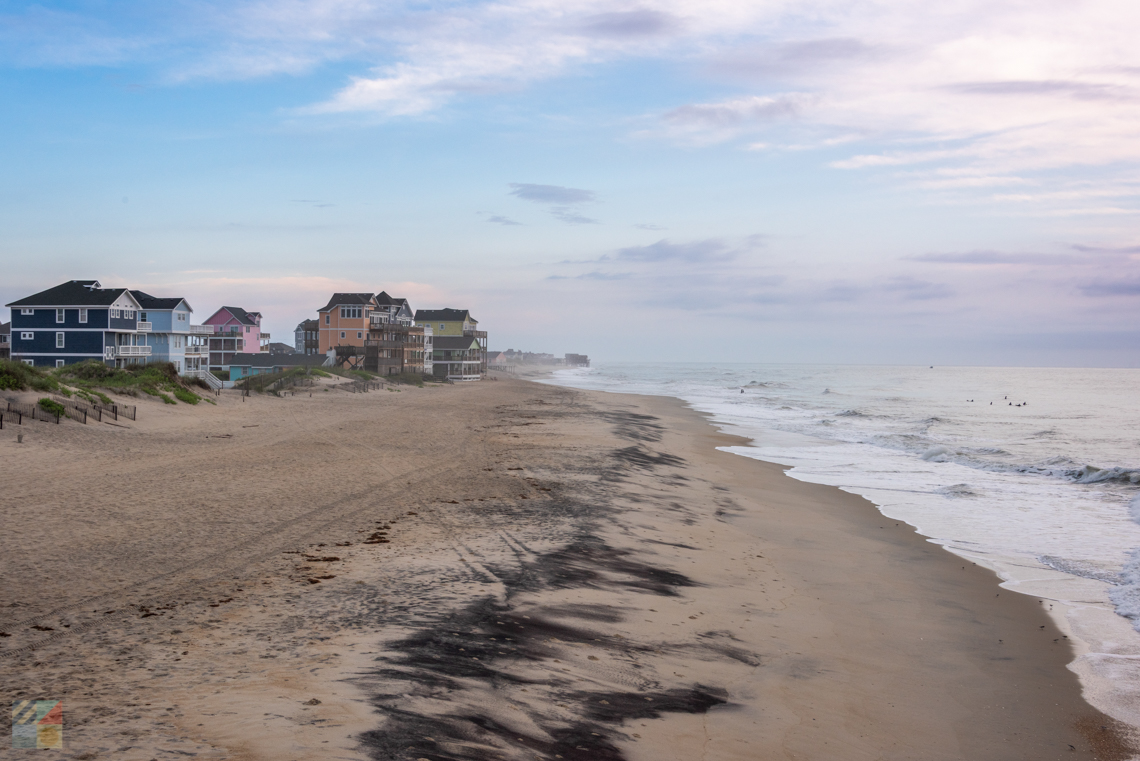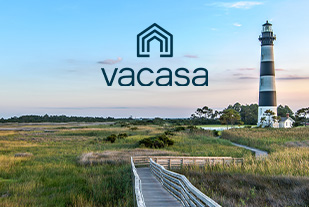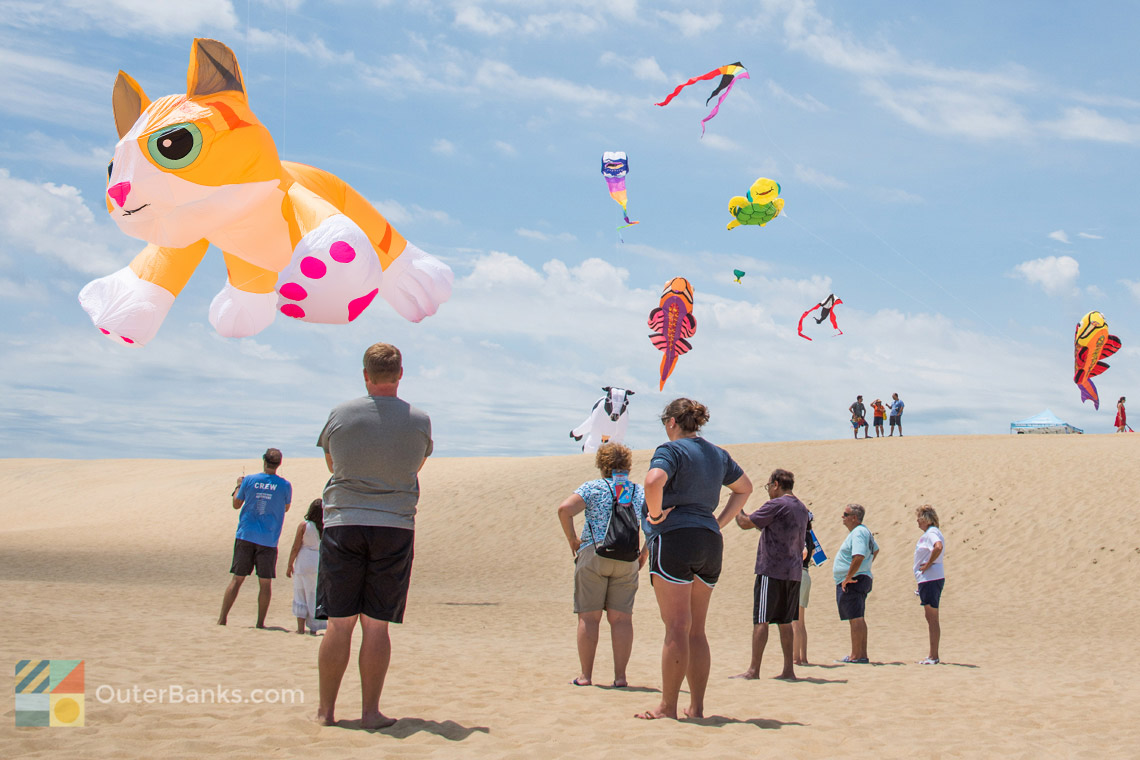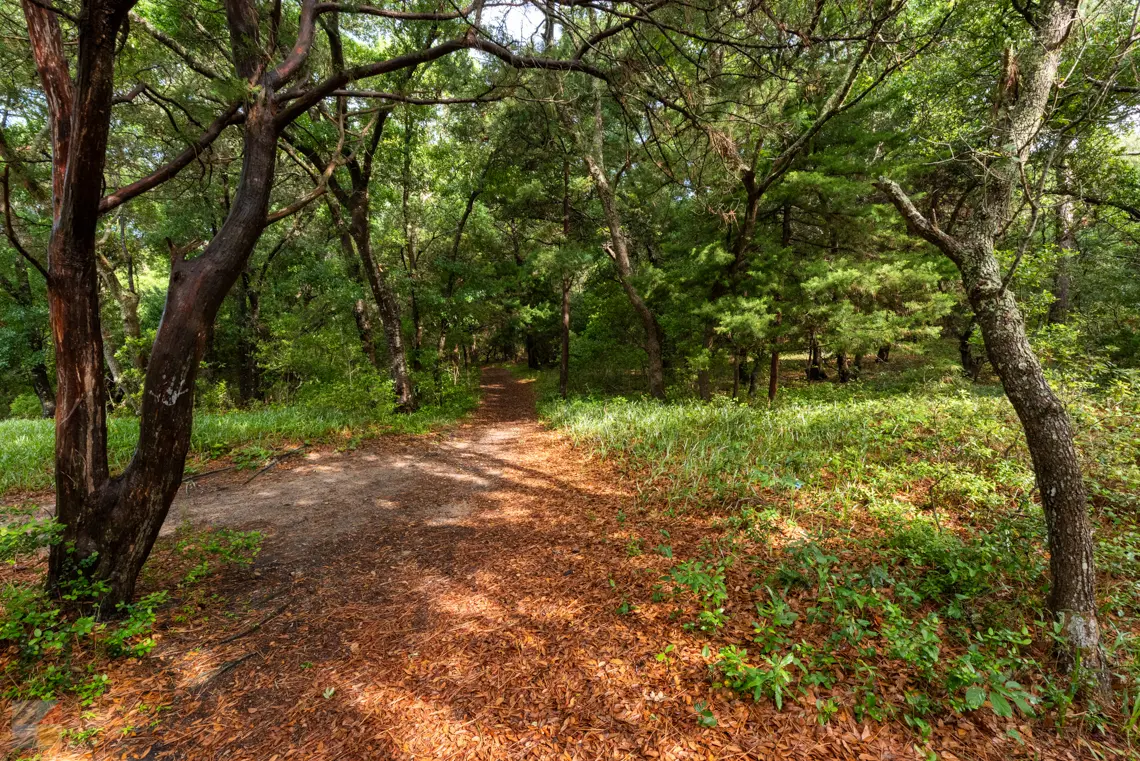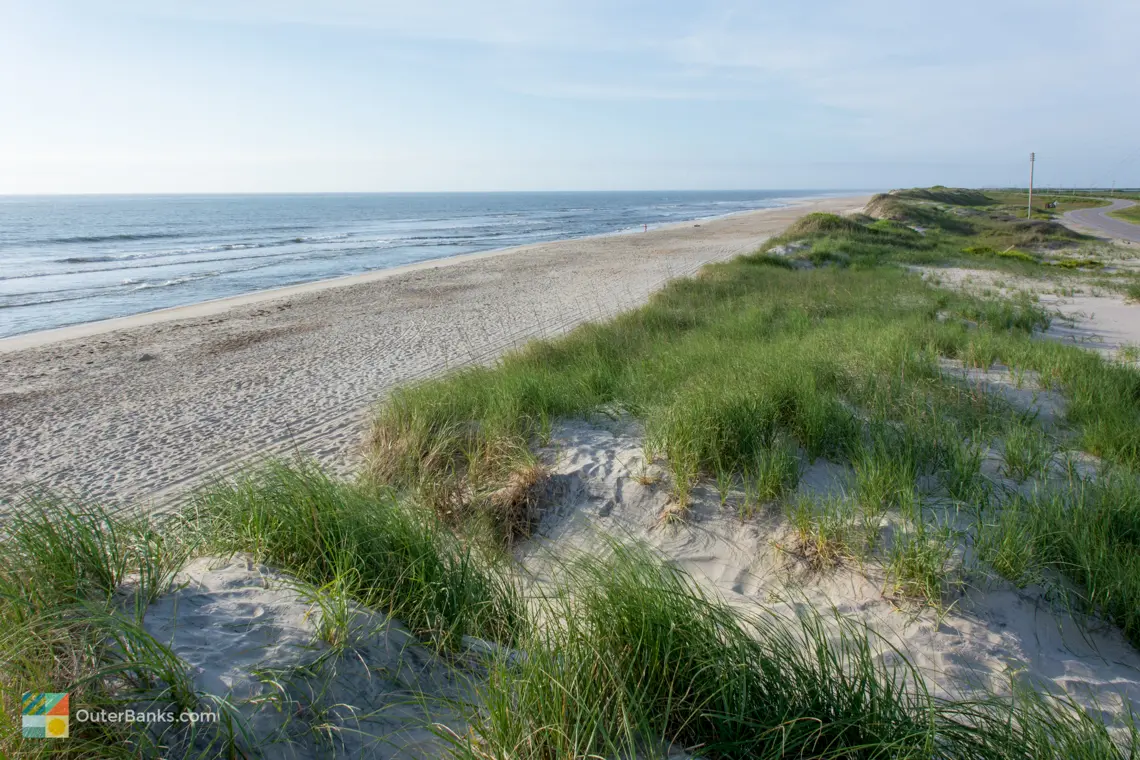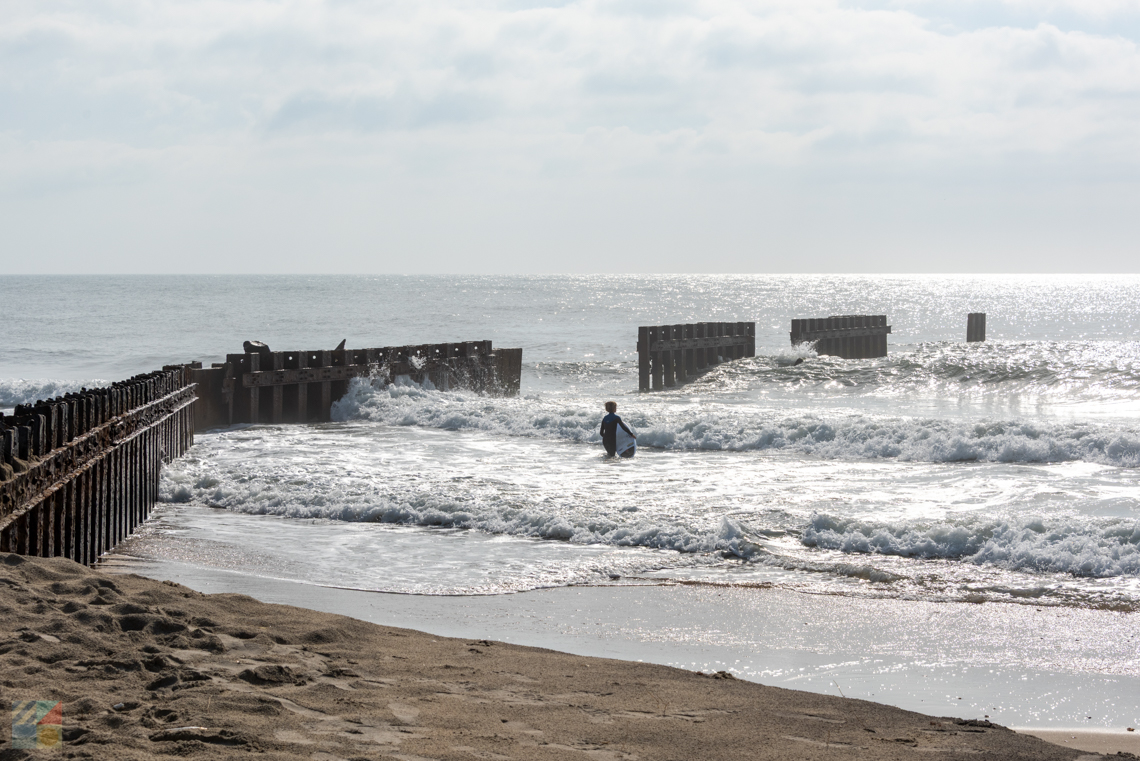Rodanthe Guide Sections:
- Where to Stay
- Attractions
- Beach Guidelines
- Upcoming Events
- History
- Rodanthe Today
- Frequently Asked Questions
Rodanthe Listings
Rodanthe has gained notoriety as the setting for Nichols Sparks' popular novel and subsequent film "Nights in Rodanthe." However, Rodanthe has long been the setting for incredible stories, such as daring oceanfront rescues, dangerous hurricanes, and, more recently, spectacular beach holidays. Rodanthe visitors can expect the romance of wind-swept beaches and quiet coastal cottages, as well as modern Outer Banks facilities like celebrated kiteboarding schools and launching spots, and local gift shops and locally run restaurants. For a romantic vacation that's miles away from the real world, with some of the best water sports access on the East Coast, Rodanthe is definitely worth a visit.

Where to stay in Rodanthe
Vacation Rentals
Sun Realty offers the largest selection of rentals in the Outer Banks. Choose from a wide range of amenities, including private swimming pools, hot tubs, theater rooms, game rooms, pet friendly lodging and more. Our properties span the entire OBX coast including Carova, Corolla, Duck, Southern Shores, Kitty Hawk, Kill Devil Hills, Nags Head, and South Nags Head. On Hatteras Island, we proudly offer beach cottages in all villages... www.sunrealtync.com
Resort Realty offers premier Outer Banks vacation rentals from Corolla to Hatteras Island. Choose from a wide range of vacation rentals from small, classic beach boxes to luxe, lavish oceanfront homes. Resort Realty has a vacation home for everyone. Browse our website at www.resortrealty.com or give us a call at 800-458-3830 and our vacation specialists will be happy to help you find the perfect home!
Brindley Beach Vacations offers premier real estate and property management services on the entire Outer Banks. Representing more than 600 vacation rental homes, Brindley Beach caters to all regions from the south beaches of Hatteras Island, Frisco, Buxton, Avon, Rodanthe, Waves, Salvo, to Nags Head, Kill Devil Hills, Kitty Hawk and north to Southern Shores, Duck, and Corolla, as well as the 4WD area of Carova Beach. As a result, vacationers will find a wide range of homes or lots to choose from, from sunny condos with a host of amenities to massive sandcastles on the edge of the beach.
Surf or Sound offers weekly vacation rentals of premier vacation rental homes from single family beach cottages to expansive oceanfront estates with a wide range of luxury amenities. We serve thousands of happy Outer Banks vacationers every year and look forward to seeing you at the beach this year! Visit http://www.surforsound.com or call 866-628-0368 for more information.
Vacasa Outer Banks - With over 800 vacation rentals and all your wish-list amenities, Vacasa has vacation rentals for every group and budget. Our local team is dedicated to providing the best vacation experience for everyone, whether you are a longtime visitor of the Outer Banks or looking to plan your first stay. With our professional team and 24/7 customer service, we’ll be there every step of the way.
Hotels
Rodanthe Attractions

Pea Island National Wildlife Refuge - Just North of Rodanthe (and South of Nags Head) lies the 13 mile-long, 30,000 acre Pea Island National Wildlife Refuge. The refuge is famous for hosting 400 species of birds and other wildlife. Birding, kayaking, wildlife education for kids, fishing and crabbing.
Chicamacomico Lifesaving Station - Commissioned by the federal government in 1871 to save the lives of sailors off the dangerous Outer Banks coast, this and six other lifesaving stations would become the foundation of the United States Coast Guard. Visitors can tour the grounds to see how the lifesavers lived and the equipment they used.

Rodanthe Fishing Pier - Conveniently located to visitors of the tri-villages (Rodanthe, Waves and Salvo), this pier has hosted anglers for decades The pier was recently reconstructed with 170' added, and the pier house offers bait, tackle, drinks, snacks and more.

Pamlico Sound - Watersports are huge on Hatteras Island, and visitors to Rodanthe swarm to the Pamlico Sound for its breezy conditions. You'll find some of the country's best kiteboarding and windsurfing conditions here.

The Beach - If you dream of secluded beaches, look no further than the tri-village beaches. The beaches of Hatteras Island are managed by the National Park Service as part of the Cape Hatteras National Seashore. Here are some things to know about Rodanthe beach policies:
- Pets are allowed on a leash no longer than 6ft, year-round. Pets are prohibited on designated swimming beaches. Service animals are allowed at all times.
- Fireworks are not permitted in Rodanthe.
- Beach fire permits are required. Print, sign and keep your paper permit with you (permits available here). From May 1 to November 15, beach bonfires are only allowed at Coquina Beach, the villages of Rodanthe, Waves, Salvo, Avon, Buxton, Frisco and Hatteras, and the Ocracoke day use area. From November 16 - April 30, Beach fires are allowed throughout the park. Fires are allowed from 6am - 10pm. An adult must be present. Fires must be on greater than 3 feet in diameter. Fires must be built and maintained below the high-tide mark and 50 feet from any vegetation. Fires cannot be left unattended, and must be extinguished upon end of use. The area must be cleaned up.
- Beer is allowed on the beach. Wine and liquor are not officially permitted. Please drink responsibly.
- Metal detecting is NOT allowed within National Parks.
- There are no lifeguard stations in Rodanthe.
- It is illegal to walk on the dunes, and it is also illegal to pick live sea oats growing on the beaches.
- Fill in any holes you dig. Holes in the sand can be a hazard.
- Be mindful of Noise. Most communities consider a violation of the noise ordinance to be any sound that can be heard from inside a nearby residence, and any load noise after approximately 11:00 p.m.
- No glass on the beach. Be mindful of glass bottles. Alcohol is allowed on all beaches, but if at all possible, stick to cans and plastic to save future beach-goers from any bare foot injuries.
- Surf fishing is allowed. A fishing license is required in North Carolina and can be obtained before your vacation via the NC Marine Fisheries and Wildlife website, or a fishing license can be purchased at most any tackle shop on the Outer Banks.
- 4x4 Driving on the Beach - The beaches of Hatteras Island and Ocracoke Island are managed by the Cape Hatteras National Seashore. Permits are required, and can be purchased online and sent via mail, or in person at one of the following locations: Coquina Beach office, Cape Hatteras Light Station, and the Ocracoke Visitor Center. Each vehicle must have its own permit. Vehicles must be registered, licensed, insured, and have a current safety inspection if required in home state/country. Vehicles must have low-pressure tire gauge, shovel, jack and jack support board. A spare tire, first-aid kit, fire extinguisher, trash bags, flashlight and tow straps are recommended. ATV's and UTV's are not permitted. Night driving is generally allowed from November 16 through April 30. See current access ramps and beach closings by visiting this page and clicking on the "daily beach access map". Obey all posted signs.
Upcoming Rodanthe Events
July 17th, 2025 2:00 PM
Visitors can take a step back in time and learn how the heroes of the original US Life-Saving Service performed their daring rescues and everyday duties through this special live demonstration that’s held on the grounds of the oceanside Chicamacomico Life-Saving Station.
August 16th, 2025
Come celebrate one of the most important events in Life-Saving local history with this special day at the Chicamacomico Life-Saving Station Historic Site in the heart of Rodanthe. The rescue of the Mirlo was one of the most legendary rescues that was ever conducted by the US Life-Saving Service, and during this special day, visitors will dive deeper into this story courtesy of a wealth of activities that will fascinate visitors of all ages.
October 14th, 2025 - October 19th, 2025
The Outer Banks, and the Pea Island National Wildlife Refuge in particular, is known as one of the best bird watching destinations in the world, and the annual Wings Over Water celebrates this distinction like no other local festival. The weeklong event, which is held each October, features a wide range of educational programs, lectures, and opportunities to meet and greet with fellow birders. During this year's festival, attendees will also have the opportunity to go on guided birding trips, attend art and photography workshops, take a tram or kayak tour of National Wildlife Refuge, visit an ancient maritime forest, and much, much more. A complete schedule can be found online at the organization's website, and attendees should note that some programs do cost a small fee to participate.

Rodanthe History
Newcomers to the Outer Banks may notice the integration of the word "Chicamacomico" in reference to the town, in either local conversations or on sign names and brown historical markers along quiet NC Highway 12. The town was originally named Chicamacomico until 1874, when the United States Post Office separated the populated area into three distinct villages, and gave "Rodanthe" its current name.
Long before the Post Office stepped in, however, the town was already nationally recognized as one of the country's greatest lifesaving stations on the East Coast. The Chicamacomico Lifesaving Station was, in fact, the very first station established along the coast of North Carolina, and proved to be a heroic and dedicated branch of the lifesaving service, which is now the modern US Coast Guard. Many folks, local and otherwise, even attest that the small Chicamacomico Lifesaving Station helped prove the necessity of a national coastal military branch, and essentially founded the current Coast Guard.

Tales of heroism are in no short supply in Rodanthe, but one of the most popular legends revolves around the doomed British Tanker, The Mirlo, which in 1918, was bombarded with torpedoes by a passing German U-Boat. In the aftermath, six Chicamacomico crew men jumped into the water, and rescued 47 out of the 57 passengers on board, earning the crew the Golf Life Saving Medal from the United Kingdom, and the Grand Cross of the American Cross of Honor from the United States.
The Chicamacomico Lifesaving Station was decommissioned in 1954 to make way for the newly established US Coast Guard, but because of its history in instrumental role in modern lifesaving techniques, the station was preserved and is now home to one of the area's most treasured landmarks.

Today, visitors are invited to explore the original Chicamacomico Lifesaving Station. The complex includes the main building, which acts as a small museum and souvenir store, as well as many outbuildings such as a storage equipment house, original bunkers, a cook's quarters, and other storage or sleeping rooms that were necessary for the original workforce.
While these structures are no longer in active service, visitors can still see the skills and maneuvers that made the station a national lifesaving landmark during seasonal "drills" using original apparatus and equipment. In these public presentations, modern US Coast Guard Service men and women carry out a deep ocean rescue using the same equipment as their late nineteenth-century colleagues. Seasonal demonstrations are free and available to the general public. The Chicamacomico Lifesaving Station grounds, museum, and gift shop are available to the public seasonally, Tuesday through Saturday, from Easter to Thanksgiving. All Hatteras Island visitors are encouraged to stop by, investigate, and obtain a better understanding of the innate toughness that the local Outer Banks community is known for.

Rodanthe Today
Not too far from the Lifesaving Station's ground, across the street on NC Highway 12, spring and fall visitors will notice a clutter of brightly colored and exceptionally large kites gliding over the Pamlico Sound. The tri-village areas of Rodanthe, Waves, and Salvo have become synonymous with kiteboarding, as the open miles of Pamlico Sound have become perfect playgrounds for kiteboarders of all skill levels. Other water sports enthusiasts, such as kayakers, windsurfers, and stand-up paddle boarders are also welcome to get their toes wet in the water, and enjoy the local water sports scene.

Just north of Rodanthe, the desolate beaches and soundside marshlands attract a variety of outdoor lovers from all backgrounds, most notably, surfers and birders.
The "S-Curves," a stretch of NC Highway 12 that lies just outside of the village has been a training ground for experienced East Coast surfers for decades. On a hot summer day when the waves are big, it's not unusual to spot dozens of cars and even camera crews parked along this stretch of highway, enjoying the action in the Atlantic waves. Nationally recognized as one of the Eastern Seaboard's best ocean breaks, surfers come from miles around to test their skills against dozens of homegrown local surfers. The result is an oceanfront show that even non-surfers can enjoy from the comfort of beach chairs on the uncrowded beaches.

Fishermen will also find plenty of fun in Rodanthe, with exceptional fishing both off the beaches, and from the Rodanthe Fishing Pier. The pier has suffered some damage throughout the years with the occasional passing hurricane, but it has always recovered and reopened to welcome seasonal anglers who want to drop a line in the deep Atlantic waters. From the side of the pier, anglers can expect to real in mullet, pompano, cobia, drum, and even occasional small sharks.
The 13 miles stretch of land from the town border of Rodanthe to the Herbert C. Bonner Bridge comprises the Pea Island National Wildlife Refuge. One of the most famous East Coast vacation destinations for birders, the refuge features over 400 varieties of year-round and migratory species of birds, ranging from Great Blue Herons to the exceptionally rare White Pelicans. The refuge features a small visitors' center, as well as a series of nature trails that guide visitors from the parks' outskirts on NC Highway 12 deep into the maritime forests, marshlands, and Pamlico Sound bordering beaches.
 The Pea Island National Wildlife Refuge has become so renowned, in fact, that it is home to one of the birder community's most treasured annual festivals, the "Wings Over Water" event. This week-long event allows visiting birders to explore the grounds with local experts, by foot, kayak, or guided boat, and celebrate and compare notes with other avid birders. Open to everyone, visitors are encouraged to check out the Wings Over Water's website to see what educational and entertaining sessions on are the program, and how to sign up and join in on the fun.
The Pea Island National Wildlife Refuge has become so renowned, in fact, that it is home to one of the birder community's most treasured annual festivals, the "Wings Over Water" event. This week-long event allows visiting birders to explore the grounds with local experts, by foot, kayak, or guided boat, and celebrate and compare notes with other avid birders. Open to everyone, visitors are encouraged to check out the Wings Over Water's website to see what educational and entertaining sessions on are the program, and how to sign up and join in on the fun.
As for accommodations, Rodanthe has a small number of campgrounds for vacationers who want to rustically relax and enjoy the beach life, as well as a number of gorgeous vacation rental homes. Rental homes in Rodanthe range from the small coastal cottage to the sprawling beachfront mansion, complete with a private pool, rec room, theater room, hot tub, and all the comforts of home. These vacation rental homes are available for weekly rental, or partial-week rentals for last minute reservations, and are represented by local Hatteras Island property management companies. (And yes, believe it or not, you can even rent the "Night in Rodanthe" home too.)
For beach-goers, it should also be noted that the town of Rodanthe is part of the National Park Service's (NPS) Cape Hatteras National Seashore, so all federal park guidelines should be followed. Pets, bonfires, and even beach driving are all allowed, however, there are restrictions and rules in all arenas. A visit to the NPS's website before your vacation will outline all the guidelines in relation to the Hatteras Island seashore, and will ensure you're up to date on the local Do's and Don'ts.
For a beach vacation that is literally miles away from the rest of the world, filled with stormy romance and plenty of on-the-water fun for everyone in the family, it's hard to beat Rodanthe. The romantic little town that has spurned dozens of sea-worthy adventure stories is also a dream vacation destination for families who adore a good quiet beach, and a lot of history. On your next Outer Banks vacation, take a trip to Rodanthe, and see why this little town has inspired storytellers to spread the word of all of Rodanthe's romantic and fun-filled possibilities.
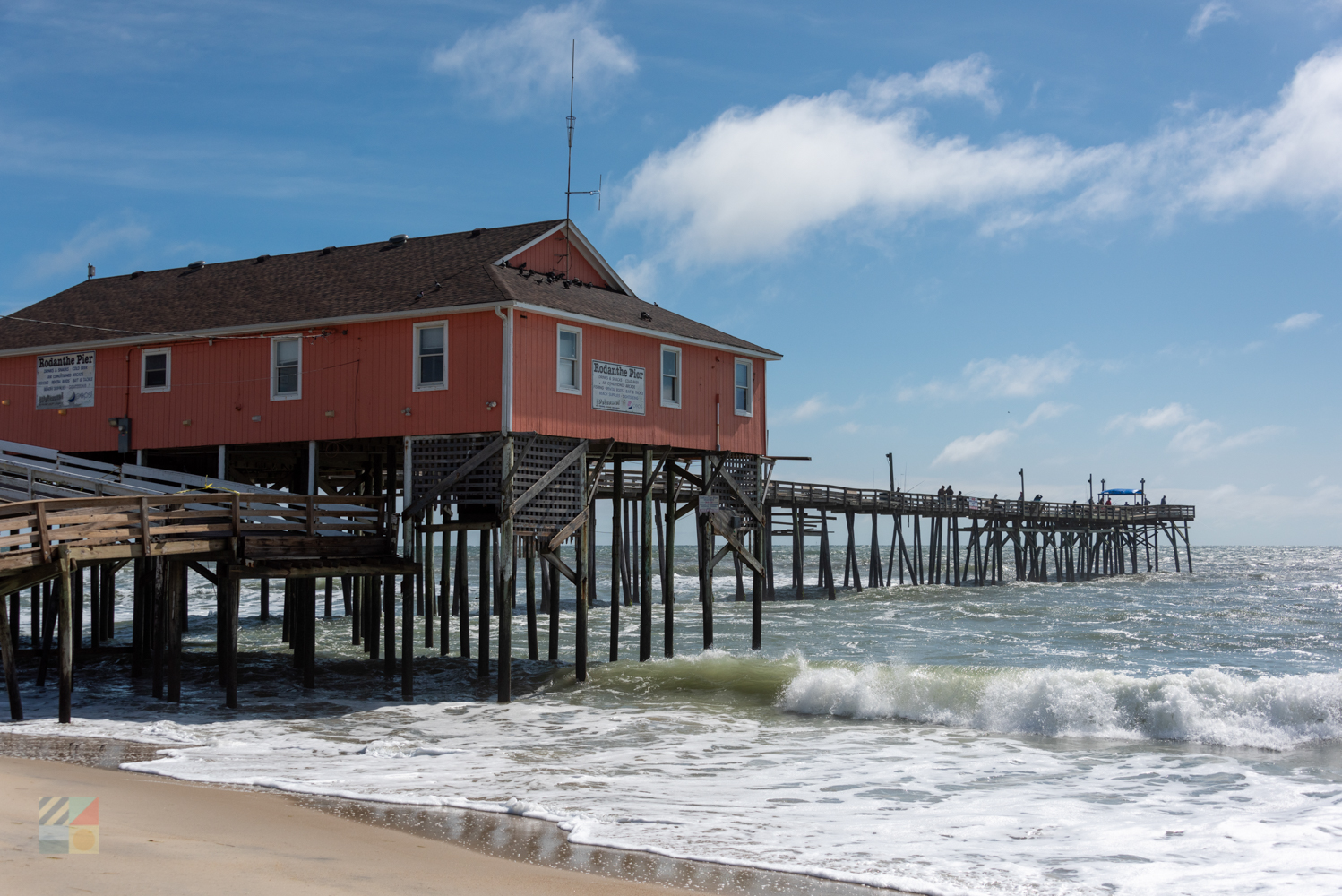
Frequently Asked Questions
Where is Rodanthe, NC?
Rodanthe is on Hatteras Island in the Outer Banks. It is the northernmost town on Hatteras Island, and borders the town of Waves to the south, as well as the Pea Island National Wildlife Refuge to the north.
How do you get to Rodanthe, NC?
Rodanthe is located 23 miles south of Whalebone Junction, which is where US 64 and US 158 connect. It can be reached via NC Highway 12 South.
How do you pronounce Rodanthe?
Rodanthe is pronounced as a three syllable word with a long “O” and “E” sound – “Row-Danth-ee.”
Where is Chicamacomico?
Chicamacomico is the historic name of Rodanthe, and refers to the original Native American inhabitants that lived in this northern section of Hatteras Island. Today, the word “Chicamacomico” can be found throughout the town in street names and local landmarks, like the historic Chicamacomico Life-Saving Station.
What is there to do in Rodanthe, NC?
Rodanthe is part of the Cape Hatteras National Seashore, and as such, it is best known for its exceptional oceanfront and soundfront beaches. The town is a popular destination for surfing, kiteboarding, windsurfing, kayaking, swimming, fishing, and just enjoying the shoreline. Rodanthe also has a number of shops and restaurants, as well as an amusement center and a local museum, the Chicamacomico Life-Saving Station.
Where was Nights in Rodanthe filmed?
Several scenes of Nights in Rodanthe were filmed in the town of Rodanthe on Hatteras Island. The “Inn at Rodanthe” bed and breakfast where the movie takes place is actually a vacation rental home in the community called “Serendipity.” Additional scenes were shot at the Rodanthe Pier, and at local stores like the former JoBob’s Trading Post.
Where is the Nights in Rodanthe house?
The Nights in Rodanthe House, known in the book and movie as the “Inn at Rodanthe,” is located on Beacon Road in the town of Rodanthe. It is currently a vacation home that can be rented on a weekly basis.
Where are the beach accesses in Rodanthe, NC?
Because Rodanthe is part of the Cape Hatteras National Seashore, all beaches in the community are open to the public. Multiple beach accesses are located at the end of oceanfront streets in town, and at community landmarks like the Rodanthe Pier.
What are the attractions in Rodanthe, NC?
Rodanthe is home to the historic Chicamacomico Life-Saving Station, one of the first life-saving stations on the Outer Banks, as well as the “Inn at Rodanthe” where the film Nights in Rodanthe was set. Rodanthe also borders the Pea Island National Wildlife Refuge, and is part of the Cape Hatteras National Seashore.
Where do you stay in Rodanthe, NC?
Visitors to Rodanthe can stay at one of the town’s many vacation rental homes or condos, or at one of the town’s campgrounds and RV parks. There are no motels or hotels in Rodanthe.
What can you do on a rainy day in Rodanthe, NC?
Rodanthe has an amusement center which features a laser tag arena, an arcade, and other activities for visitors of all ages. On a rainy day, visitors can also tour local attractions like the historic Chicamacomico Life-Saving Station. The town also has a number of shops and restaurants, and is located 30 minutes away from central Outer Banks attractions like the North Carolina Aquarium on Roanoke Island.
Where can you surf in Rodanthe, NC?
Rodanthe has two popular surfing destinations: the S-Curves and the Rodanthe Pier. The S-Curves refers to the curvy stretch of NC Highway 12 just north of town, while the Rodanthe Pier is located in the center of Rodanthe.
Where can you kiteboard in Rodanthe?
Rodanthe has numerous kiteboarding centers and soundside access points throughout the town. Kiteboarding in both the Atlantic Ocean and the Pamlico Sound is popular in Rodanthe.
Are pets allowed on the beach in Rodanthe, NC?
Pets are allows on the Rodanthe beaches provided they are leashed at all times, as Rodanthe is part of the Cape Hatteras National Seashore.
Can I drive on the beach in Rodanthe, NC?
ORV ramps are found just south of the tri-villages, (Rodanthe, Waves and Salvo), and 4WD vehicles can access the beach via ramps 23, 25, and 27. Seasonal closures may apply. Visitors can often drive on the beaches in Rodanthe in the winter months, generally from October to March.
Do you need a permit to drive on the Rodanthe beaches?
4WD vehicles must obtain a beach driving permit to drive on the beaches in the Cape Hatteras National Seashore. Permits can be picked up in person at the National Park Service stations near Oregon Inlet or the Cape Hatteras Lighthouse, or can be obtained online.
Are beach bonfires allowed in Rodanthe?
Beach bonfires are permitted throughout the town of Rodanthe, NC. A permit is required, and can be obtained through the National Park Service’s website or local ranger stations.
When is the best time to visit Rodanthe?
Rodanthe is most popular in the summer months, when businesses, shops, and restaurants are open, and the beaches are warm and sunny.
What are the average air temperatures each month in Rodanthe?
January - high: 52°, low: 36°F
February - high: 54°, low: 38°F
March - high: 60°, low: 43°F
April - high: 69°, low: 52°F
May - high: 77°, low: 59°F
June - high: 84°, low: 69°F
July - high: 88°, low: 73°F
August - high: 86°, low: 72°F
September - high: 81°, low: 68°F
October - high: 72°, low: 58°F
November - high: 64°, low: 49°F
December - high: 56°, low: 40°F
Rodanthe Photos



-
Avon Farmers Market
July 15th, 2025 9:00 AM - 1:00 PM -
Mustang Mornings at the Farm
July 16th, 2025 10:00 AM - 2:00 PM -
Surfing For Autism
July 17th, 2025 - July 19th, 2025
Corolla Wild Horse Tours knowledgeable guides will ensure you and your family have a great wild horse tour! Along the way the guides will stop and point out interesting sites and local history and details of the Corolla Wild Horses history. Be sure to ask them lots of questions and keep them honest! Call or book today and come see our living history!
Perhaps the reason that this area of maritime forest goes unnoticed, (an area which in fact comprises the majority of Frisco Village), is simply because the oceanfront beaches just yards away are too alluring to ignore, and garner the lion's share of vacationers' interest. This is understandable, as when most folks think of an Outer Banks vacation, they envision miles of unspoiled beaches, refreshing ocean waves, and plenty of room to spread out a beach blanket, and Frisco's beaches have all of these attributes in spades.
Off the beach, one of the best activities for groups to enjoy in the Outer Banks is mini golf, bumper cars or Go-Karts. Thankfully, Paradise Fun Park offers all three activities! Paradise Fun Park offers exciting outdoor activities that kids and adults of all ages can enjoy together. Families flock to Paradise Fun Park for a fun-filled day of putting competition. Grab a scorecard, select a ball and putter and get to the green! Paradise Fun Park offers a challenging variety of putting greens for hours of entertainment. Be sure to keep score and crown your group champion.
The Chicamacomico Lifesaving Station is one of Rodanthe's greatest treasures. This historical lifesaving station has been a popular attraction for Hatteras Island visitors for decades, and stands on the very edge of the small town of Rodanthe. Over the years, this station has been battered by hurricanes, ocean and soundside flooding, and ferocious gusts of winds, and yet it is still standing, and serves as a proud reminder of Hatteras Island and the Outer Banks' rich lifesaving history.
Wine, beer and cheese lovers will love TRiO, an exciting retail and tasting destination in Kitty Hawk. Both a gourmet retail wine, beer and cheese shop as well as a bistro with a wine bar and tap house, TRiO offers the best of the worlds of wine, beer and cheese for your enjoyment on premise or in the comfort of your home. TRiO's bistro is elegant and comfortable, with a large bar and two-story dining and bar area. The gourmet bistro menu of appetizers, and light fare such as cheese and charcuterie, paninis and salads make TRiO a wonderful lunch and dinner restaurant. Unique and high-tech self service WineStations are available in the downstairs bar area, where you can sample full, half and tastes of wines of all regions at varying price ranges. If you prefer beer, you can select from 24 beers on tap or try a TRiO Flight and sample a taste of four beers. In the upstairs mezzanine, which is part of the bistro, you'll find comfortable lounge seating and a free pool table.
Seasoned visitors to Ocracoke Island love to soak in its rich heritage and culture which dates back to the 1500s, and features some legendary and longstanding residents. Some of the most popular Ocracoke locals are the Wild Ponies, which are protected in a secluded 180 acre area enclosure on the soundside of the Cape Hatteras National Seashore, but can still be enjoyed by anyone passing through the island on NC Highway 12.
Best Pizza in in Corolla since 1995! Cosmo’s Pizzeria has continued to be a family favorite on the northern Outer Banks for over 15 years. Outdoor dining, full bar, and specialty menu (including gluten-free pizza) are a few of our many highlights. Take Out, Dine-in our comfortable bar or chill out on our breezy patio.We hope to see you and your family the next time you’re visiting the OBX!
Beach canopies and umbrellas create shade, lower ambient temperatures and block UV rays on hot, sunny Summer days. Sitting under the canopy of a quality beach umbrella can make the difference between comfort and sweltering. When choosing an umbrella, we look for durability, wind ratings, weight and size.
Jockey's Ridge State Park is an unmistakable landmark for Nags Head vacationers and virtually everyone passing through along the main beach bypass, US 158. This park is marked by its towering sand dunes, which reach 80' - 100' feet tall and look more at home in a vast dessert than in a coastal beach town. These dues are barren, and made up of nothing but Outer Banks sand, providing an incredible playground for hang gliders, sand boarders, and anyone who doesn't mind a long hike and some incredible island-spanning views.
We love to highlight some of the best and most interesting Outer Banks restaurants, shops, attractions and activities. Read on to discover some of our favorites!
Low Country Seafood from the islands. North, South, East or West, our menu will satisfy any cravings you have while on your beach vacation! Let us do the cooking tonight! Reseservations and Outdoor Seating available. We’ve got something for everyone in the family—from cocktails and mocktails to daily fresh catch specials, kids meals, desserts and more—the whole gang can relax and enjoy.
Explore Hatteras Island at its natural best with a visit to the Pea Island National Wildlife Refuge. Covering 13 miles of Cape Hatteras National Seashore land, this attraction is hard to miss, although there aren't many giant signs, hotels or businesses to point the way. Instead, visitors will find a completely undeveloped parcel of land, that's well-stocked with gorgeous views and serene nature trails that are ideal for off-the-beaten path excursions.
If you're searching for great pizza on the Outer Banks, look no further than Cosmo's Pizzeria at The Marketplace in Southern Shores! We offer authentic New York-style pizza made fresh and just the way you like, using only the highest quality ingredients. Try one of our specialty pizzas, such as the classic Margarita or BBQ Chicken, or keep it simple with your choice of toppings. If New York-style pizza isn't your thing, we also offer a variety of salads, pasta dishes and subs.
Avid Outer Banks Surfers and sightseers alike are familiar with Old Lighthouse Beach, a stretch of sand in the heart of Buxton that was once the sight of the Cape Hatteras Lighthouse. Convenient and renowned for its good shelling and great waves, during a typical Hatteras Island summer's day, it's not unusual to see dozens of visitors with boards and board shorts scoping out the scene.
